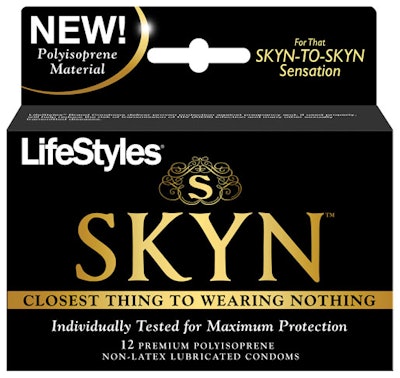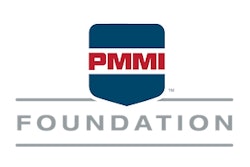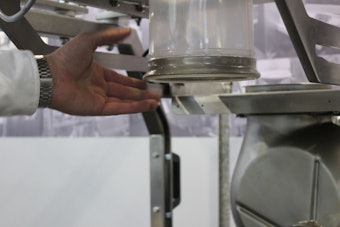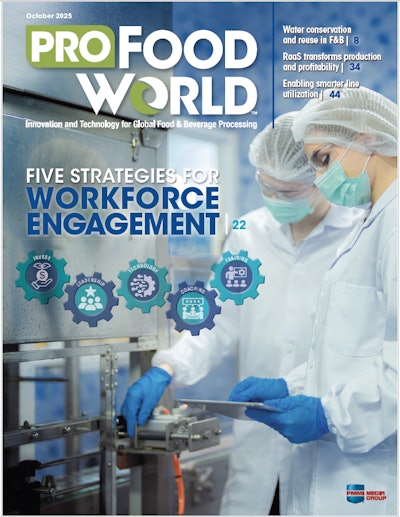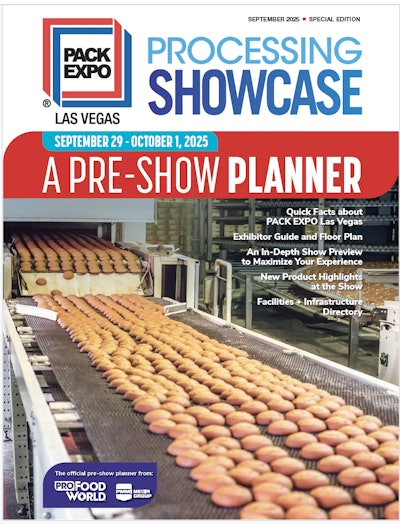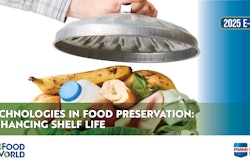Cartons with a solid black background direct consumers to focus on the
LifeStyles SKYN product name, which is printed in gradient yellow tones
to help give the lettering a regal gold appearance. The thin, sleek
copy font aims to deliver a sexy contrast from the dry, boxy typeface
typically found on condom packaging.
That’s according to a press release issued by Red Bank, NJ-based Ansell
Healthcare Products, whose Consumer Products arm introduced LifeStyles
SKYN prophylactics last summer.
“Most people don’t know that condoms are a medical device,” says Carol
Carrozza, vice president of marketing for LifeStyles SKYN condoms.
“That means the products have to go through rigorous testing and be
approved by the Food and Drug Administration before they go to market.”
That was the case with LifeStyles SKYN, which is marketed as the first
and only clinically approved polyisoprene, nonlatex condom, designed to
provide greater sensation and comfort than other non-latex or natural
rubber condoms. Targeted towards males aged 18 to 30, SKYN “is a new
material, so that if people are allergic to latex, they have an
alternative that’s gone through FDA standards and tests and clinical
trials, is safe and effective, yet is comfortable and provides
sensitivity,” Carrozza says.
Theft-protection devices
The primary foil pack is provided by suppliers in Asia that ship the
material to Ansell’s packaging plant in Dothan, AL. Either three or 12
foil-packed condoms are automatically filled by an R.A. Jones
(www.rajones.com) cartoner into cartons supplied by Carton Service,
Inc. (www.cartonservice.com). Carrozza says Carton Service also adds a
theft-prevention device to the carton.
“We are required by the retailers to source-tag each pack to help
reduce pilferage,” she says. Ansell uses tags supplied by Sensormatic
(www.sensormatic.com) and Checkpoint Systems
(www.checkpointsystems.com). “The condom category is perceived as a
high-pilferage category,” she notes. “These devices have helped us
recover some inventory over the years.”
Marketing strategies
Available in either a three-pack for $3.95 or a 12-pack for $12.99,
LifeStyles SKYN condoms are also sold to public health agencies and
clinics, where Carrozza estimates Ansell accounts for 70% of that
market. “It’s interesting that the condom market is smaller than most
people think,” she says. “In retail dollars, according to Neilsen, it’s
about a $300 million market in the U.S., but that’s just what’s
measured at food stores, drug stores, and mass merchandisers. It does
not include Wal-Mart, which does a tremendous volume, as you might
guess.”
Although Ansell sells condoms at a reduced rate to health agencies and
clinics, Carrozza believes that it’s “the right thing to do because
it’s a difference maker. People who are fairly young and first becoming
sexually active often become initiated into family planning or sexual
healthcare devices by going to a clinic where a nurse or a doctor is
teaching them about their options. That actually supports our
commercial market, in that some people simply can’t afford to go into a
drugstore and buy the product, so they are going through the clinic.
Eventually they will come into the commercial market as well. So there
really is a very good companion strategy.
“The polyisoprene product doesn’t require different packaging
materials, but we do have to prove to the FDA that this material is
acceptable and effective. So, we have conducted accelerated [aging]
tests to prove that the condom performs and is as effective [after a
certain time has passed].” She says the shelf life of the polyisoprene
condom is three years, less than the five years for traditional
condoms. “That’s because these are so new that we won’t be able to
claim five years until we have real five-year data,” she says.
“We worked with Webb Scarlett deVlam (www.webbscarlett.com) on the
package design,” she says, noting, “the [condom] category is an
interesting one because people still can be embarrassed to buy this
product in the store. They don’t know who is behind the counter. They
might have to
ask for the product if it is behind the counter. And there are not a
lot of advertising dollars in the condom category. So we had to try to
communicate as much on the packaging as we possibly could to generate
sales and try to communicate that SKYN should be viewed as a different
product.”
Carrozza says consumer testing determined that the gold lettering and
black color provided a premium, masculine appearance that appealed to
the target male audience. It also helped in the eight to 10 seconds it
typically takes for a consumer to make a decision whether to buy the
medical device or not. “It’s a quick decision sometimes,” Carrozza
notes, “because they don’t want to be seen standing there. It [may be]
embarrassing to pick up a [condom] package and read it. This package
looks good. Copy on the pack says to them that it is sensitive, that
it’s the closest thing to wearing nothing.”
The retail market itself
presents challenges to condom makers. Carrozza says there are
“limitations driven by the retailer because they are constrained by
space. Another in-store challenge to marketing condoms, she points out,
is the glare from store lights, and that some retailers sell condoms
behind a lock and key.”
Despite those challenges, Carrozza says Ansell is considering the
rollout of more SKUs, “because the early indications are that the sales
are very good.”
